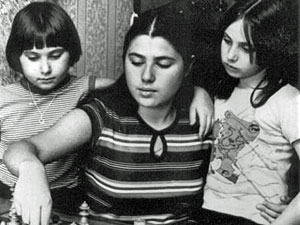The wrong bishop
By Frederic Friedel
The endgame bishop and pawn against a lone king is generally won, even if the bishop doesn't control the queening square of the pawn. A tempo move or two will dislodge the defending king and the promotion is inevitable. However there is one important exception. This is when the pawn is on the edge of the board and the bishop does not control the promotion square.
In my previous article I gave our readers a study to solve, one I had shown to a number of famous people over the years. I asked you people – implored actually – to solve the problem yourself, and to keep a record of the time it required. After the detailled article on wrong bishops our readers probably knew exactly what this study is all about and what they needed to look for.
J. Vancura, Ceske Slovo 1922
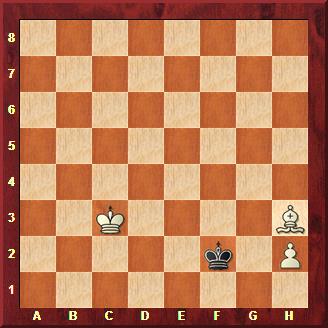
White to play and win
One of the first people I showed this study to was GM Isván Bilek, during the Microcomputer World Chess Championship in Budapest in 1983. He gave me a wrong line, then reexamined the position together with an IM colleague and, moving piece on the board, found the correct move in a total of 15 minutes.
On the same trip I showed the study to the 14-year-old Zsuzsa Polgar. She sat in front of the board, never touched a piece, glanced up occasionally at me, and then, after 17 minutes, dictated the entire solution correctly.

Susan Polgar with her little sisters in Hungary in 1983
The next day I showed the study to Susan's sisters Sophie and Judit. Sophie was eight at the time, and Judit was almost seven years old. While eating apples and cake they tossed the pieces around the board, coming up with the correct solution ("Sooo simple!?") in 22 minutes.

Mikhail Botvinnik (right) with Ken Thompson in 1983
In the same year there was a Computer Chess World Championship in New York, and the guest of honour was ex world champion Mikhail Botvinnik. One day he visited the Bell Laboratories and at some stage was sitting in the chess club section of the cafeteria, waiting for a lecture to begin. I set up the four pieces on the board in front of Botvinnik. He looked at the position, and after a minute or two he said "White win?" I nodded and he immediately showed me – a wrong line. I made the refuting move and he set up the pieces in the original position. Then he sat there without moving until, with a wry little smile, he executed the correct first move. The whole thing took him about ten minutes.
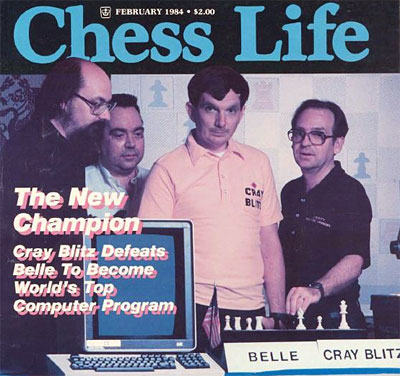
On the day after the Computer Chess World Championship I showed the position to the new title winner Cray Blitz. The program, running on a million-dollar 80 mega-flop machine (80 million floating point operations per second, which is about one thousand times slower that the latest Nvidia graphics chip) spent 13 seconds considering a wrong key move – with a logical +4.032 score. Then, at ten ply, it switched to the correct move and displayed +10.878. Mikhail Botvinnik saw this all happen – he was not at all happy that a computer was able solve the position so effectively by pure brute force, without the chess knowledge he so ardently advocated.
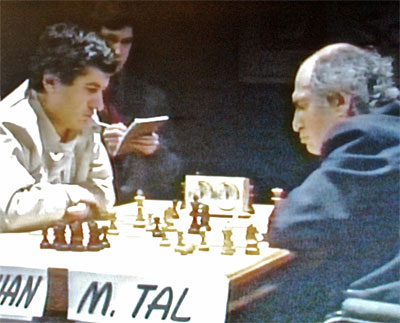
I also showed (dictated, actually) the study to Mikhail Tal (above right) during a Candidates tournament in Saint John, Canada, where at the age of 51 he won the official World Blitz Championship ahead of Kasparov and Karpov. Mikhail simply grinned and said: "I know it, Frederic – it is famous endspiel."
How to solve the study
I was going to simply give you a replay board with the solution (it is included below, with the trys of Bilek and the Polgar sisters), but our ChessBase India editor Sagar Shah showed me that he had described the solution didactically on his chess blog three years ago. He did such a good job of explaining the study that I will quote it in full.

How should we go about solving this one. Let us start with some logical analysis. Black threatens Kg1, so we have to move the bishop. But where must it go? Our primary aim in this position is to prevent the black king from reaching h8. So the farther we move the bishop, the better it is. The black king must not be able to gain a tempo by attacking it on its way to h8.
So we play 1.Bc8 Ke3! (an important endgame principle of shouldering: the white king is not allowed to join the battle. 1...Kf3? would be a mistake as after 2.Kd4! Kf4 3.h4! Black finds himself in zugzwang.)
2.h4 Ke4! 3.h5 Ke5 4.h6 Kf6 and Black makes an easy draw.
Once we have made this preliminary analysis what is to be done? We need to search for a pattern in our mind regarding what we know of such endgame. When I started to solve this position, I knew only one pattern in which white wins such an endgame. Lets have a look at it.

The black king cannot get to h8 and cannot approach the pawn, because the g5 square is guarded. The white king will slowly push away his black counterpart and queen the h-pawn.
Now let us use this pattern in our initial position. If we play 1.Bf5 Ke3 2.h4 Kf4 wins a crucuial tempo and we dont even need to analyse further – it's a draw. We can be trickier with 1.Be6 Ke3 2.h4 Ke4 3.h5 Ke5 4.h6. Of course the bishop cannot be taken now, so Black plays 4...Kf6 5.Bf5!? (stopping Kg6) 5....Kf7 (Black now threatens Kg8) 6.Bh7 Kf6! We have the same pattern as in the previous diagram with one problem: the white king needs to be on g4 but instead is on c3! Without the king's help its just a draw: 7.Bc2 Kf7.
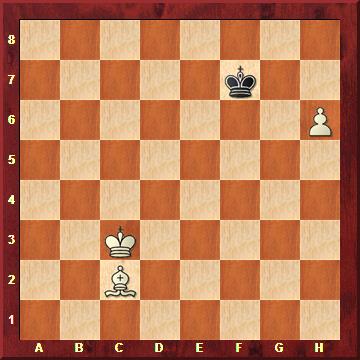
White cannot prevent the black king from reaching h8 or capturing the h-pawn
Initial calculations having been done and previously remembered patterns recollected, we still couldn't find the answer. But we could conclude one very important thing: as the black king is shouldering the white king, the job of keeping the black king away from the g7-h8 squares must be achieved with the pawn and the bishop.
So we try to imagine setups by which we keep the black king away with just the bishop and pawn. This requires some imagination and also the belief that such a setup actually exists! If you try really hard you will find the following:
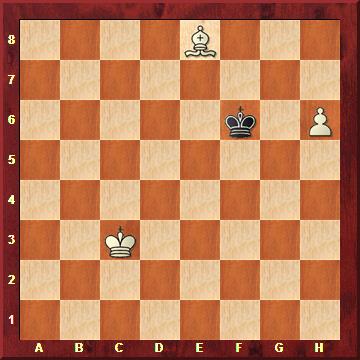
What a position! The bishop and the pawn alone cover all the important squares and keep the black king at bay! The white king is not even required for queening the pawn. Black is in zugzwang and the h-pawn promotes.
Once you have envisaged this position, the answer becomes very easy. 1.Bd7!! Ke3 2.h4 Ke4 3.h5 Ke5 4.h6 Kf6 5.Be8!+-. I would recommend for all players: whenever you solve a combination or a study, after you have finished solving it take a minute to commit the pattern to memory. If you do that you will enlarge your arsenal with so many patterns and ideas that you will be able to solve problems at scintillating speeds! For now I would recommend you to start your journey of pattern memorization with the above diagram, so that whenever you have a bishop and a wrong colour pawn you know what to aim for and do not just settle for a draw!
Replay the solution and all the lines:

[Event "Ceske Slovo"] [Site "?"] [Date "1922.??.??"] [Round "?"] [White "Vancura, J."] [Black "White to play and win"] [Result "1-0"] [SetUp "1"] [FEN "8/8/8/8/8/2K4B/5k1P/8 w - - 0 1"] [PlyCount "9"] [EventDate "1985.??.??"] 1. Bd7 $1 (1. Bg4 $2 Ke3 2. h4 Kf4 3. h5 Kg5 4. Kd4 Kh6 5. Ke5 Kh7 6. Kf6 Kh8 $10) (1. Be6 $2 {Try: Zsofia+Judit Polgar} Ke3 2. h4 Ke4 $1 $10 (2... Kf4 $2 3. Kd4 $18) 3. h5 Ke5 4. h6 Kf6 5. Bf5 Kf7 6. Bh7 Kf6 $1 7. Bc2 Kf7 $11) (1. Bf1 $2 {Try: GM István Bilek} Ke3 2. Bd3 Kf3 $1 (2... Kf4 $2 3. Kd4 Kg5 4. Ke5 Kh4 5. Bf5 $18) 3. Kd4 (3. h3 Kg3 $1 4. Bf5 Kf4 $10) 3... Kg4 $10) (1. Bc8 $2 Ke3 $1 ({After} 1... Kf3 $2 2. Kd4 Kf4 3. h4 $1 {Black is in zugzwang.}) 2. h4 Ke4 $1 3. h5 Ke5 4. h6 Kf6 {and Black makes an easy draw.}) (1. Bf5 $2 Ke3 2. h4 Kf4) 1... Ke3 2. h4 Ke4 3. h5 Ke5 4. h6 Kf6 5. Be8 $1 $18 1-0
More puzzles to solve
Here's a chance to apply your knowledge of the wrong bishop ending to practical positions.
Author unknown, 1961
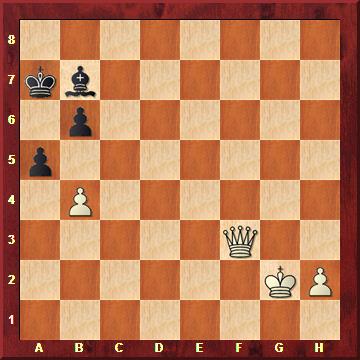
White to play and draw
The white queen is pinned and the temptation is to simply play 1.Qxb7. After the king recaptures White can go 2.h4 or 2.bxa5, but in either case discovers that Black promotes on a1 first, blocking a white promotion on h8. So what to do? Hint: the black bishop can only control white squares, while the promotion square a1 is black. Please spend at least ten minutes pondering this position, best of all with a physical chess board and wooden pieces. You can do it!
V Kosek, 4.hm Ceskoslovensky Sach

White to play and win
This one is quite difficult. The trick is of couse to prevent the black king from getting to g8/h8 and preventing any white hopes of promotion. So the first move must prevent that from happening. And then White must manoeuvre very carefully to continue preventing Black from getting there. The best option for you to solve this to play against your chess engine without looking at the best moves it expects from White (minimize or undock the engine window). It will be frustrating to see how the computer will keep holding a draw in what looks like completely won positions. However there is a subtle and convoluted path to actually secure the full point.
We will publish the full solutions to both problems here in the next few days.
